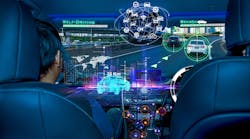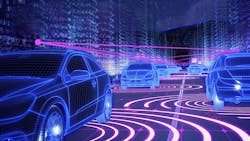This article is part of the 2022 Electronic Design Forecast issue
What you’ll learn:
- The technology that’s necessary for ensuring safety in autonomous driving, including the importance of LiDAR.
- Where autonomous driving stands today and what consumers/businesses are looking for.
Where do we stand with autonomous vehicles and autonomous driving, and what does the future hold? Phononic’s Alex Guichard answers some of the main questions surrounding this ever-evolving technology.
Where does autonomous driving currently stand? How close is society to seeing autonomous vehicles on the road and how far are we from seeing autonomous driving become ubiquitous/much more common?
Currently, autonomous driving and vehicles have reached level 2 of autonomy. This means that the vehicle can control both steering and accelerating/decelerating, but the driver is still able to take control at any time. The goal is to reach level 5, which will result in fully autonomous driving cars on the road without the need for drivers behind the wheel – whether they are used for everyday consumer driving or commercial needs such as delivery services.
As of now, there are two approaches for reaching this level of driving: low cost, which aims to create high-performance within a reasonable budget; and high-performance technology, which technicians are trying to make less expensive. This proves that cost and performance are prominent factors in the development of these technologies.
The issue is that there’s no clear path to success, and it often leads to a “seesaw” effect: When you try to improve one, the other doesn’t usually improve with it. It’s unclear which approach will win the race to bring this technology to the road. However, development is happening fast and furiously.
What is LiDAR’s role in autonomous driving?
LiDAR technology is a critical piece of an autonomous driving system to ensuring safe operation on the road. LiDAR is essentially the “eyes” of the autonomous vehicle, creating a three-dimensional map of the world around the car.
To detect objects on the road and in the path of driving, the LiDAR sensors within the detecting technology need to have a long detection range and a fast refresh rate for their field of view. If the eventual goal is to reach full level 5 autonomy, high-performance LiDAR is a necessity.
Safety continues to be a factor in autonomous driving and is a current challenge for manufacturers. What requirements ensure that LiDAR sensors are providing the needed data to the vehicle’s perception algorithms so that they act quickly and safely?
For autonomous driving to continue to grow and innovate, many qualifications must be met for the LiDAR sensors, including:
- Long range, high resolution, high refresh rate, and a large field of view
- Ability to work in rain or sunshine
- Ability to work in a very wide operating temperature range
- Rejects interference from ambient light or even other LiDAR sensors
- Long lifetime and high reliability
Lasers and detectors inside of the LiDAR sensors must be in a stable environment to be able to deliver on those performance requirements, regardless of the environment around the vehicle itself. What’s more, that first list of requirements trade off with one another. It’s very difficult to improve how far the sensor can see down the road without narrowing how widely it can see, or how quickly it’s updating that picture.
Given lasers don’t perform well in elevated temperatures or humidity, it’s essential that cooling chips are used in these compartments to ensure a controlled temperature. Thermoelectric coolers (TECs) are a solution to this problem, as the chips are designed to cool the environment to the desired operating temperature.
Autonomous driving is a bit like the Wild West, with new technology and startups popping up, and with so much still unknown. What are consumers and businesses looking for, and how can they navigate this space?
It’s an exciting time to be a customer or a manufacturer in the industry because, like the Wild West, there’s still lots of “unknown” coupled with myriad opportunities for growth with autonomous vehicles. Manufacturers and technical experts are working closely with customers to meet their needs and taking on challenges together, exploring innovative technology and solutions and brainstorming unique partnerships.
There are two types of technical expert customers in the industry right now—those coming from the fiber-optics space and those from other advanced driver-assistance system (ADAS) technology companies.
The experts within the fiber-optics space understand how TECs work and the benefit they can provide to the sensitive semiconductor components inside the LiDAR sensor. On the other hand, while experts from other companies involved with ADAS may understand the technology needed for the vehicles, they may not understand cooling technology or how that can result in better outcomes for the overall sensor. As a result, two different approaches are required when working with customers.
In addition, the design cycle for modern automotive technology (estimated anywhere from five to 10 years) is a lengthy process—significantly longer than the traditional design process. Given how much can change on the technical front in this time frame, customers and manufacturers need to be flexible. They may have a five-year plan to bring their autonomous vehicle to level 5, but in that time, new inventions, technology, or a new consumer may emerge.
Consumers are finding it difficult to trust autonomous driving due to safety concerns and the limited information available about the technology used. How can LiDAR technology help to ensure the safety of consumers behind the wheel?
In the end, both types of customers—optical technology experts as well as automotive systems manufacturers—are looking to create safe solutions for autonomous driving. The media coverage around pilot programs that have resulted in crashes or technology shortcomings leading to disasters is a reason many don’t trust autonomous driving.
Recent research found that only 29% of drivers in the U.K. said they would feel safe with their own fully autonomous vehicle. It will be a long road to building that trust and feeling of safety.
Most people believe that the three-dimensional moving pictures created by high-performance LiDAR sensors are the only machine-vision approach that can enable high-level autonomous driving. Similarly, we believe that the only way to deliver on all of the requirements placed on the LiDAR sensor is to use TECs to cool and stabilize the temperature of the most critical optical components of the sensor.
The more we understand LiDAR technology and work to develop it properly, the more society will trust this revolutionary invention.
Read more articles in the 2022 Electronic Design Forecast issue

